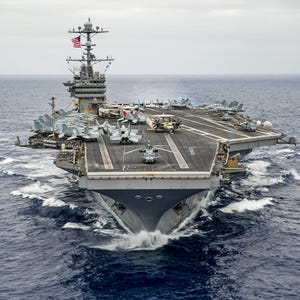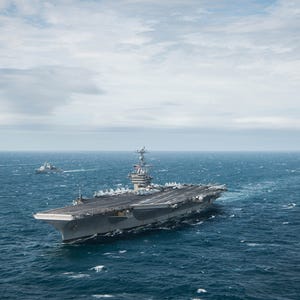Carrier George Washington returns to Norfolk after 7 years
By Lance M. Bacon, Staff writer
ABOARD USS GEORGE WASHINGTON — It was a homecoming seven years in the making as the carrier George Washington returned to Norfolk on Dec. 17, the base she left in 2008 to serve as the forward-deployed carrier in Yokosuka, Japan.
“This isn’t just any port,” said Lt. Cmdr. Rasaq Balogun, the carrier’s services officer. “This is Norfolk. This is Hampton Roads. This is homecoming for the George Washington.”
Getting home was anything but easy for this crew.
The GW on May 18 departed Japan on its last Pacific patrol. Half of its crew cross-decked to Ronald Reagan in August and headed back to Japan; half of the Reagan crew embarked “G-Dub” and headed south. In the next 100 days, the blended crew covered 24,177 nautical miles as they circumnavigated South America. They conducted two multinational and three bilateral exercises, flew 2,958 mishap-free sorties, cleansed the ship of 2,137 slimy polywogs, awarded 1,700 enlisted warfare qualifications, hosted 1,500 visitors from eight nations, and made four port visits — and they were still not done.
With GW’s arrival in Norfolk for its mid-life refueling, 1,400 sailors began the last leg of an historic hull swap that will see them serve on three carriers in four months. Dubbed the “Three Presidents Crew,” the Ronald Reagan sailors who transferred to George Washington will fly back to San Diego to man Theodore Roosevelt before Christmas.
The GW will make history of its own, as it swaps half of its crew not once, but twice, with 1,300 sailors returning to Norfolk from San Diego to man the spots vacated by the Three Presidents Crew.
“Ride all three carriers on a three-carrier hull swap, nobody else in the world has done this before,” said Command Master Chief Franklin “Spike” Call, who is part of that crew. “They have straight-up bragging rights. … The sailors from Japan coming stateside, they have done something no one else has done: They are going to see three different crews. That is heavy lifting at its finest.”
A family affair
“Bittersweet” is not a term to describe most homecomings, but it captured the atmosphere aboard the ship on the eve of this final swap. This was not one ship with two crews; sailors from every deck and department took ownership of the carrier as it completed this historic hull swap.
“People have made family here,” said Call, who will now become CMC of Theodore Roosevelt. “When you step away and transfer, it is never easy. Especially after doing something as difficult as this has been. We fast became family, and now we’re breaking the family up to go and do it all over again.”
Capt. Timothy Kuehhas, the ship’s skipper, admitted that one concern he had going in was whether the Three Presidents Crew would take ownership of George Washington during their four months aboard, or treat it as a stint on their way to TR.
“They took immediate ownership,” he said. “What I learned from this experience is that USS George Washington, that name defines the hull. But the crew defines the ship.”
One example is Lt. Alexey Diaz, who will have served as flight deck officer for all three carriers when the dust settles.
“I told my team, ‘This is not a three-month deployment and then we go back to another ship,'” he said. “We took ownership and tried to make her as good as we can with the time we have. I’ve grown to love her.”
Call said success was about gaining trust, “little by little, literally hour by hour.”
The transition plan was in the works one year before Reagan and GW conducted the first of three swaps. Crews studied ships’ plans to coordinate strategies and overcome differences; a handful of engineers cross-decked ahead of time to help with the transition, and each carrier will conduct tailored training to familiarize new crew members with that ship’s unique features and personality. Though the same class of ships, they were built decades apart and have differences.
“Making sure sailors understood the differences of each platform was a challenge,” said Diaz, an 18-year vet who has seven carrier tours to his credit. He pointed out how Reagan has more real estate with which to work. For example, GW’s jet blast deflector on Cat 2 crosses the foul line, which shuts down Hornet shots during aircraft recovery. Not so on Reagan, which also has more space between the foul line and island to park aircraft.
It was all a matter of managing relationships, according to Lt. Cmdr. Greg Curl, aircraft handling officer. A limited duty officer with 23 years in uniform, he rode GW from Norfolk to Yokosuka as flight deck officer in 2008, and checked aboard in January to bring her home. He has seen a 60-percent turnover along the way, and will see it again later this month.
“We can talk about this book and that manual, but I have to get to know what you’re doing, and you have to get to know what I’m doing, so we can integrate with others,” he said.
Rounding South America
This unprecedented swap was needed to keep a six-carrier presence the Pacific, according to Pentagon officials. The GW is scheduled to be in the yard from 2017 to 2021 for a mid-life refueling. The move got underway in March when Theodore Roosevelt bid Virginia farewell after 28 years and set sail on a world cruise bound for San Diego. Two months later, CTF-70 and CVW-5 brought GW to San Diego, then rode Reagan back to Japan. Rear Adm. Lisa Franchetti and 100 members of Carrier Strike Group 9 left Reagan to bring GW to Norfolk. On the way, the strike group participated in the multinational UNITAS exercise — in both the Pacific and Atlantic. This year marked the first time a full carrier strike group participated in the exercise, officials said.
It was especially good for Aviation Boatswain’s Mate 3rd Class (AW) Rodolfo Canoalva. It gave him the chance to hook up with his brother, Santiago, who is a lieutenant in the Peruvian navy.
“It was the highlight of this cruise,” Rodolfo said. “It was my first encounter with both navies. I grew up looking at that [Peruvian] navy for 13 years of my life. Being on a carrier was my dream since I was a little guy. Being on a carrier in Peru, and seeing both flags beside each other, it was very emotional.”
But this was no dog and pony show. Carrier flight ops are not common in that part of the world. Seas become increasingly difficult the farther south you go; divert airfields are unfamiliar to most pilots. Kuehhas credited the proactive approach of Capt. Max McCoy, the Carrier Air Wing 2 commander, with alleviating problems.
Even things such as resupply proved challenging — like restocking shelves. All meats, poultry, and fish have to be USDA approved. The GW stocked up on them before leaving San Diego — it packed eight chill boxes; most carriers bring only two on deployment.
Balogun, the services officer, was able to buy fresh bread, fruits, and vegetables in foreign ports. That gave sailors the chance to sample exotic flavors, but some purchases proved rotten.
Sailors were without eggs for the last leg of the cruise. Thousands bought Dec. 4 in Brazil passed initial inspections, but many were found to be bad once cracked open.
“It is the nature of the business,” he said. “Once you discover it, you quarantine it and you have to get rid of it. Sailors love their morning breakfast with eggs, but the line for medical cannot be longer than the line for chow.”
Balogun and his team made up for it by serving steak and crab legs, capped off with an ice cream social, the night before pulling into Norfolk.
Keeping the ship’s store stocked was also a challenge. The crew had an insatiable taste for Snickers bars and beef jerky; keeping energy drinks such as Monster and Red Bull on the shelf was near-impossible. And “there are a few people on this ship who drink Diet Coke, but they are dedicated,” Balogun said. “If you run out, they will let you know.””
One time he ventured into Chile and bought the local version, “Coke Light.” The Diet Coke diehards “didn’t beat me up about it because they knew I did everything I could to bring them something,” he said. “And that sold out, too.”
In all, roughly 9,000 sailors were part of the three-carrier swap. The skippers and executive officers stayed with the hulls while command master chiefs remained with the crews. More than half of those crews ended up back at their original homeport.
Whether another three-hull carrier swap will follow remains to be seen, but one thing is for sure: Call would not be in favor.
“There has never been a three-carrier hull swap in the Navy, and I certainly hope there isn’t another one because it’s hard,” he said. “It’s not that anything was bad about it. It’s not that the Navy didn’t plan this out right. It’s not that people were mean to each other. It’s that this is emotionally tough. You’re breaking up a family, you’re joining another family. It’s bittersweet.”
Back to Top

